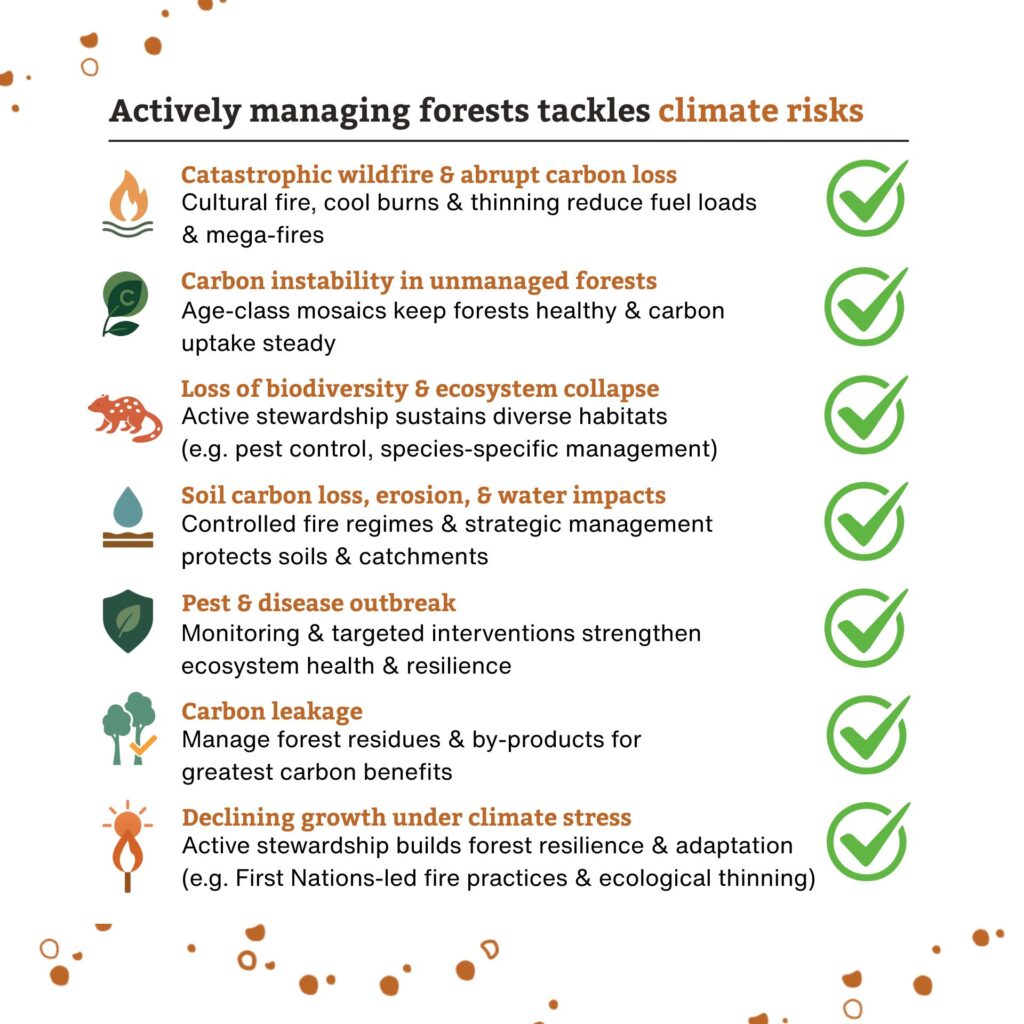At the Foundation, we focus on practical, science-led actions that make forests safer, healthier and more resilient in a warming climate. Here’s how active management reduces risk and the evidence behind it.
Catastrophic wildfire and abrupt carbon loss
Lower fuel loads through cultural burning, prescribed burning and targeted thinning. These treatments consistently reduce subsequent wildfire severity1,2, with Australian eucalypt studies showing the strongest effect when thinning is combined with burning3. Planned fire is a standard part of national risk management, complementing suppression4. Effectiveness declines under the most extreme weather, so residual risk still rises – another reason to pair fuel work with climate adaptation and emissions cuts.5
Carbon instability in unmanaged forests
A mix of age classes and strategic thinning spreads risk, stabilises live carbon and reduces the chance that a single extreme event wipes out decades of sequestration. Proactive treatments cut high-severity fire occurrence and keep live carbon more stable during drought years6; where fuel reduction precedes a wildfire, total carbon loss is lower than wildfire alone7.
Loss of biodiversity and ecosystem collapse
Cultural burning and patch-mosaic fire create habitat diversity and can support species persistence when planned to fit local Country and ecology8. Multi-objective planning shows hazard reduction and biodiversity goals can be compatible when management is adaptive and place-based.9
Soil carbon loss, erosion and water impacts after severe fires
By reducing the frequency and extent of high-severity fire, active management lowers the likelihood of post-fire runoff spikes, erosion and sedimentation that damage soils and catchments10,11. Severe fires can degrade water quality for years, reinforcing the value of preventing high-severity events.10
Pest and disease outbreaks under climate stress
Ongoing monitoring, prompt removal of stressed ladder fuels and targeted interventions help break outbreak cycles that intensify after drought and heat. IPCC highlights the value of integrated, risk-based management to build ecosystem resilience12, and Australia’s national indicators point to climate-linked threats where active management and biosecurity matter.13
Declining growth under heat and drought
Assisted regeneration, selective thinning and Indigenous-led fire can maintain productivity by reducing competition for water and creating cooler, less flammable structure. Long-term studies in eucalypt systems show climate-driven growth limits and the need for adaptive, structure-focused management14.
Carbon leakage from imports
Ensure that forest residues and by-products are managed to deliver the greatest carbon benefits. This help strengthen sustainable local supply, which when paired with restoration, helps avoid exporting those impacts15.

References
-
Collins, L et al. 2023, ‘Fuel reduction burning reduces wildfire severity during extreme fire events in south-eastern Australia’, Journal of Environmental Management, 343, 118171.
-
Davis, KT et al. 2024, A meta-analysis of thinning, prescribed fire and wildfire severity, RMRS-GTR-438, USDA Forest Service.
-
Volkova, L & Weston, C 2019, ‘Effects of thinning and burning on fuel hazard’, Science of the Total Environment, 694, 133682.
-
ABARES & DAFF 2023, Australia’s state of the forests report: Synthesis 2023, Canberra.
-
Clarke, H et al. 2022, ‘The 2019–2020 fires doubled residual risk despite fuel treatments’, Scientific Reports, 12, 13876.
-
Vibrant Planet Consortium 2025, ‘Proactive forest management reduces high-severity wildfire and stabilizes carbon during droughts’, Frontiers in Forests and Global Change (news release with DOI), viewed 17 Sep 2025.
-
Weston, CJ et al. 2014, ‘Forest carbon dynamics following fuel-reduction burning and subsequent wildfire’, International Journal of Wildland Fire, 23(6), 771–780.
-
UNSW 2023, ‘Indigenous burning helped suppress extreme bushfires’, newsroom article summarising peer-reviewed research in Science, viewed 17 Sep 2025, https:
// .www .unsw .edu .au -
Cawson, JG, Penman, TD et al. 2025, ‘Decision science for multi-objective fuel management’, Fire, 8(1), 12.
-
MacDonald, LH & Robichaud, PR 2008, ‘Post-fire erosion and the effectiveness of emergency rehabilitation’, USDA RMRS, Fort Collins.
-
Colorado Forest Restoration Institute 2021, Effects of wildfires on runoff and erosion, technical synthesis, viewed 17 Sep 2025, https:
// .cfri .colostate .edu -
IPCC 2022, Climate change 2022: Impacts, adaptation and vulnerability (WG II), Cambridge University Press.
-
DAFF 2024, Indicator 3.1a: Scale and impact of agents and processes affecting forest health and vitality, viewed 17 Sep 2025, https:
// .www .agriculture .gov .au -
Prior, LD & Bowman, DMJS 2014, ‘Big eucalypts grow more slowly in a warm climate’, Global Change Biology, 20(9), 2793–2799; and Prior, LD & Bowman, DMJS 2014, Forest Ecology and Management, 334, 65–73.
-
WoodSolutions 2023, Forests, plantations, wood products & Australia’s carbon balance, Forest & Wood Products Australia, viewed 17 Sep 2025, https:
// .www .woodsolutions .com .au
Active conservationHealthy forestsPositive actions